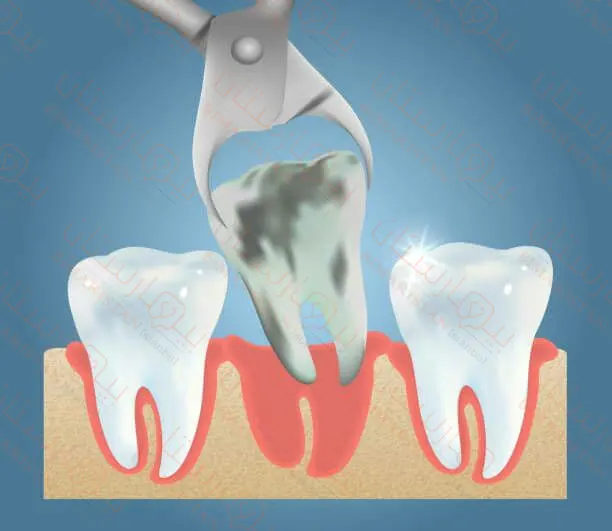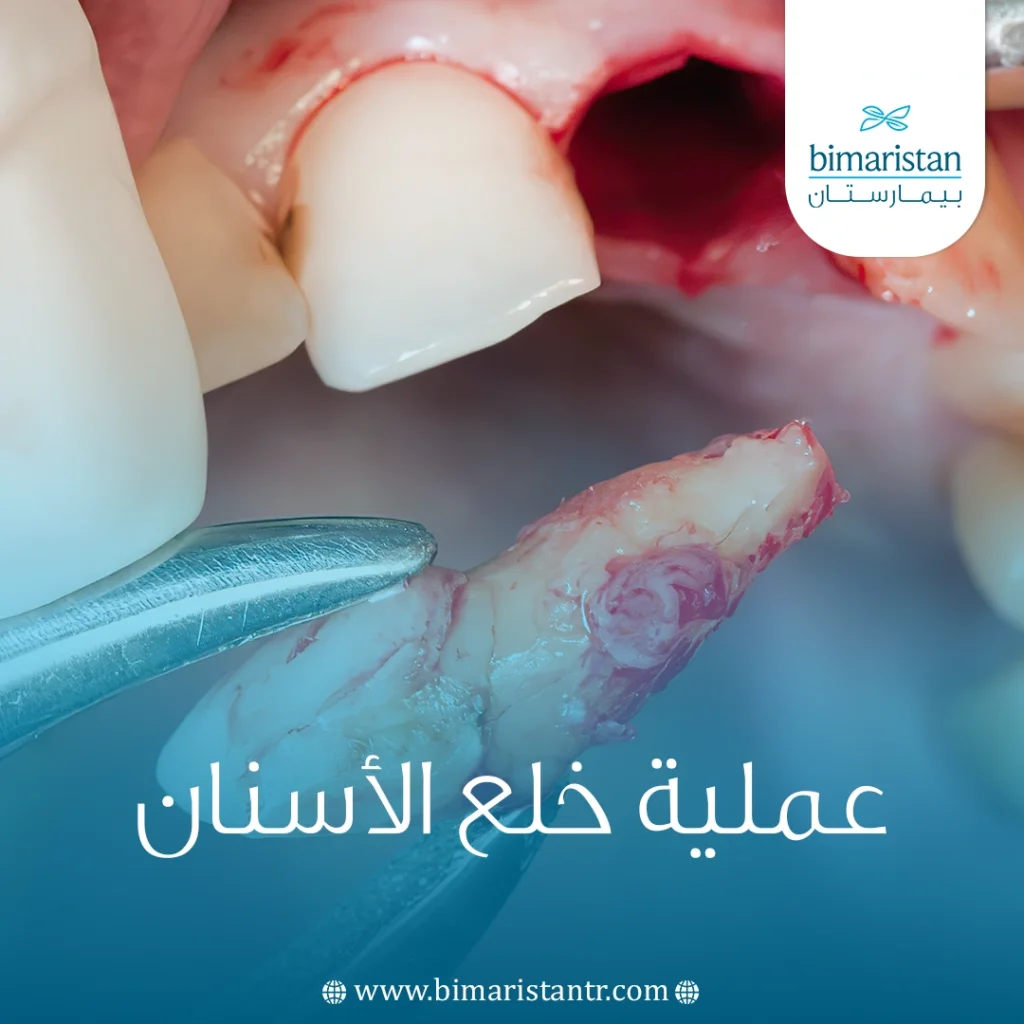تعني عملية خلع الأسنان إزالة الأسنان إما بسبب التسوس أو الرض أو الازدحام، سنتعرف في هذا المقال على الطرق المختلفة لخلع الأسنان في تركيا و على نصائح التعافي.
كل ماتريد أن تعرفه عن عملية خلع الأسنان

خلع السن هو قلع سن وإزالته من مكانه، تشير الدراسات إلى أن تسوس الأسنان والتهاب دواعم السن هما أكثر الأسباب شيوعاً لقلع الأسنان.
يقوم أطباء الأسنان وجراحو الفم بإزالة الأسنان لأسباب مختلفة تتضمن بعض الأمثلة ما يلي:
- تسوس الأسنان
- مرض اللثة
- التهابات الأسنان
- صدمة أو إصابة في السن أو العظام المحيطة
- اختلاطات ضرس العقل
- التحضير لتقويم الأسنان إذا كانت الأسنان شديدة الازدحام
- عدم سقوط أسنان الطفل في السن المناسب
أنواع عملية خلع الأسنان
يعتمد النوع الصحيح لعملية خلع الأسنان على شكل السن وحجمه وموضعه وموقعه في الفم.
يصنف جراحي الأسنان عمليات خلع الأسنان على أنها إما عملية بسيطة أو جراحية، تتضمن عمليات الخلع البسيطة الأسنان الظاهرة فوق اللثة والتي يمكن لطبيب الأسنان إزالتها قطعة واحدة.
يعتبر الاستخراج الجراحي أكثر تعقيداً ويتضمن إزالة أنسجة اللثة أو العظام أو كليهما وقد يحتاج الجراح أحياناً إلى إزالة السن على شكل قطع.
ضروس العقل هي آخر ما يبزغ وعادة ما تكون أول من يحتاج إلى خلع حيث تعتبر عملية خلع ضرس العقل إجراءً شائعاً في جراحة الفم لأنه في كثير من الحالات ينطمر أي لايخرج بشكل كامل من اللثة.
التحضير لعملية خلع الأسنان
يجري الشخص استشارة مع طبيب الأسنان أو جراح الفم قبل الخلع، أثناء الاستشارة سيطلب الطبيب تاريخاً طبياً شاملاً سيسأل أيضاً عن أي أدوية يتناولها الشخص.
يحتاج بعض الأشخاص إلى التوقف أو البدء في تناول بعض الأدوية في الأيام التي تسبق الجراحة اعتماداً على كمية الأسنان أو العظام أو كليهما المراد إزالتها، كما قد يصف الطبيب أيضاً بعض الأدوية في يوم الجراحة.
وقف مميعات الدم
كثير من الناس يتناولون أدوية تمييع الدم لمنع تكون جلطات الدم في الأوعية، يمكن أن تؤدي هذه الأدوية إلى مزيد من النزيف أثناء الجراحة.
يمكن لجراح الأسنان عادةً التحكم في النزيف في موقع عملية الخلع عن طريق:
- استخدام أدوية التخثر الموضعية على اللثة.
- تعبئة محجر السن بالرغوة أو الشاش القابل للذوبان.
- خياطة موقع الخلع.
- يمكن أيضاً أن يساعد استخدام الشاش والضغط بعد الإجراء في وقف النزيف.
ومع ذلك يجب على أي شخص يتناول مميعات الدم إخبار جراح الأسنان أثناء الاستشارة.
عادة لا يحتاج الناس إلى التوقف عن تناول مميعات الدم قبل عملية خلع الأسنان ولكن قد يحتاج الجراح إلى رؤية نتائج تحاليل دموية حديثة من أجل معرفة ما إذا كان يجب على الشخص التحول مؤقتاً إلى مميع دم مختلف أو التوقف عن تناول هذا النوع من الأدوية قبل العملية.
بدء المضادات الحيوية
في حالات قليلة قد يصف طبيب الأسنان المضادات الحيوية قبل عملية خلع السن.
قد يفعل ذلك على سبيل المثال لعلاج التهابات الأسنان ذات الأعراض المنتشرة، مثل الحمى أو الشعور بالضيق إلى جانب تورم الفم.
لا تتطلب آلام الأسنان بدون تورم مضادات حيوية، تناول المضادات الحيوية دائماً وفقاً لتوجيهات الطبيب تماماً وتجنب الاستخدام غير الضروري لها.
قد يحتاج الشخص إلى مضادات حيوية إذا كان لديه مخاطر عالية للإصابة بالتهاب الشغاف الإنتاني أو عدوى في صمامات القلب أو البطانة الداخلية لشغاف القلب.
وفقاً لجمعية القلب الأمريكية AHA فإن الأشخاص الذين يعانون من أمراض قلبية معينة لديهم مخاطر متزايدة للإصابة بهذه العدوى بعد عملية خلع الاسنان الجراحية، ذلك توصي جمعية القلب الأمريكية وجمعية طب الأسنان الأمريكية الأشخاص الذين لديهم أي مما يلي بتناول المضادات الحيوية قبل جراحة الأسنان لتقليل مخاطر الإصابة:
- صمام قلبي اصطناعي
- عملية إصلاح صمام القلب بمواد اصطناعية سابقة
- زرع قلب مع تشوهات هيكلية في الصمام
- بعض تشوهات القلب الخلقية
- إصابة سابقة بالتهاب الشغاف المعدي
التخدير أثناء عملية خلع الأسنان
سيتم إعطاء الشخص بنج (حقنة مخدر موضعي) بالقرب من مكان الخلع تؤدي إلى تخدير المنطقة حتى لا يشعر الشخص بأي ألم، سيستمر التنميل لبضع ساعات بعد الجراحة.
يمكن لأي شخص أن يطلب مخدراً إضافياً أو دواء مهدئ لتقليل القلق أثناء عملية إزالة الأسنان، قد يقدم طبيب الأسنان أو الجراح ما يلي:
- أكسيد النيتروز المعروف أيضاً باسم غاز الضحك
- دواء مهدئ عن طريق الفم
- التخدير في الوريد IV
- التخدير العام، سيكون الشخص الذي يتلقى مخدراً عاماً نائماً تماماً أثناء العملية.
بعض أطباء الأسنان ليس لديهم الخيارات المذكورة أعلاه في عياداتهم إذا احتاج أي شخص إلى أي من الخيارات السابقة فعليه إخبار طبيب أسنانه أثناء الاستشارة وقد يحيله طبيب الأسنان إلى جراح الفم.
إجراء عملية خلع الأسنان أو خلع ضرس العقل
قبل البدء في الخلع يقوم الجراح بأخذ صورة شعاعية لسن الشخص مما يساعد في تقييم انحناء وزاوية جذر السن.

بمجرد أن يقوم المخدر الموضعي بتخدير المنطقة سيبدأ الجراح في الخلع، في حال كان السن ذو جذور متعددة كما في ضرس العقل قد يقوم بإزالة السن على عدة قطع، في حال تم إخفاء السن تحت أنسجة اللثة أو العظام فقد يحتاج الطبيب إلى قطع اللثة أو إزالة منطقة العظم المسدودة.
لا ينبغي أن يشعر الشخص بالألم لكن يمكنه توقع الشعور بالضغط على السن، قد يسمع أيضاً صريراً وتشققاً في العظام أو الأسنان، يجد بعض الناس هذه التجربة مزعجة.
إذا شعر الشخص بأي ألم فعليه إخطار طبيب الأسنان أو جراح الفم على الفور، سيقوم الطبيب بإعطاء المزيد من مواد التخدير.
بعد عملية خلع الأسنان قد يكون من الضروري إجراء خياطة غرز أو إجراءات إضافية للسيطرة على النزيف، سيضع طبيب الأسنان أو الجراح طبقة سميكة من الشاش على موقع الخلع ويجعل الشخص يعضه لامتصاص الدم وبدء عملية التخثر.
التعليمات بعد عملية خلع الأسنان
فيما يلي طرق مساعدة في تقليل الشعور بعدم الراحة وتعزيز الشفاء بعد عملية خلع الأسنان.
تغيير شاش الأسنان
بعد عملية خلع الأسنان يقوم طبيب الأسنان أو الجراح بوضع طبقة سميكة من الشاش فوق موقع الخلع سيساعد العض على هذا الشاش بضغط ثابت في السيطرة على النزيف.
يجب أن يبقى الشاش في مكانه لمدة 20-30 دقيقة على الأقل سيحتاج الشخص بعد ذلك إلى استبدال الشاش عندما يتشرب بالدماء، من المرجح أن يستمر النزيف لمدة يوم إلى يومين بعد الجراحة.
السيطرة على الألم بعد خلع الضرس
يجب أن يستمر التنميل الناتج عن التخدير الموضعي لبضع ساعات فقط بعد الخلع اتصل بطبيب الأسنان إذا استمر الخدر ولم يزول.
قد يصف طبيب الأسنان دواءً لتخفيف الألم والالتهاب بعد العملية عادةً ما تكون الأدوية التي لا تستلزم وصفة طبية مثل الأسيتامينوفين أو الإيبوبروفين كافية للسيطرة على الألم بعد الخلع الروتيني.
السيطرة على التورم بعد خلع الضرس
قد يعاني الناس من تورم خفيف في الوجه في منطقة الخلع، هذا امر طبيعي قد يساعد وضع الثلج على الوجه في تخفيف التورم.

تجنب العبث بموقع الخلع
أول 24 ساعة بعد عملية خلع الأسنان مهمة للغاية، يمكن أن يؤدي إزعاج أو تهيج المنطقة إلى منع تجلط الدم بشكل فعال وإبطاء عملية الشفاء لذلك يجب على الناس تجنب:
- المص في موقع الخلع
- لمسها باللسان
- استخدام القشة
- البصق
- تناول الأطعمة الصلبة وخاصة المقرمشة
- شطف الفم والمضمضة بقوة
- شرب المشروبات الكحولية أو استخدام غسول الفم الذي يحتوي على الكحول
- التدخين
الأكل والشرب بعد خلع الضرس
بعد عملية خلع الأسنان اشرب الكثير من السوائل وتناول الأطعمة اللينة والمغذية، عندما يصبح المضغ مريحاً مرة أخرى أعد تقديم الأطعمة الصلبة ببطء، سيوصي طبيب الأسنان بالمضغ على الجانب المقابل لموقع الخلع حتى يلتئم الجرح تماماً.
التنظيف بالفرشاة والخيط
استمر في التنظيف بالفرشاة والخيط كالمعتاد بعد خلع السن لكن احرص على عدم إزالة خثرة الدم.
ابتداءً من اليوم التالي للجراحة يمكن المضمضة كل بضع ساعات بالماء الدافئ والملح، لعمل ذلك أضف نصف ملعقة صغيرة من الملح إلى كوب من الماء.
الزرع بعد خلع الأسنان
سيكون من غير المريح وجود فجوة في فمك بعد الخلع لذلك إذا قمت بعملية خلع الأسنان أو كنت تعلم أنه سيتعين عليك إجراؤها قريباً فقد ترغب بملء تلك المساحة الفارغة في أسرع وقت ممكن، ولكن.
ماهو أنسب وقت لإجراء زراعة الأسنان بعد قلع الأسنان؟
الجواب يختلف من مريض لآخر حيث لدينا عدد من الخيارات المحتملة.
الزرع الفوري مباشرة بعد عملية خلع الأسنان
في حال كانت بعض الشروط محققة يمكن وضع زرعة الأسنان في عظم الفك فوراً بعد قلع السن خلال نفس الموعد، سيكون هذا الخيار مناسباً لك في حال غياب أمراض اللثة ولديك عظم فك كثيف وصحي.
الزرع المبكر
يحدث عادة بعد 2-3 أشهر من الخلع، تسمح فترة الانتظار القصيرة هذه للثة بالشفاء وتمنح جسمك فرصة لمحاربة أي عدوى ربما كنت تعاني منها، في أغلب الأحيان سوف يسمح هذا النوع للمرضى بتجنب الحصول على طعم عظمي.
الزرع المتأخر
يتم إجراء زرع للسن بعد 3 أشهر أو أكثر من القلع، وذلك عادة ما يكون الخيار الأفضل للأفراد الذين عانوا من أضرار وتهدم في أنسجة الفم إما بسبب أمراض اللثة المتقدمة أو لأسباب أخرى.
قد تحتاج إلى ترقيع عظمي أو إجراءات أخرى قبل أن تصبح مؤهلاً لإجراء جراحة زرع الأسنان، يتوفر لدى مركزنا أحدث طرق الزرع على يد أمهر الأخصائيين في تركيا، يمكنك التواصل معنا لاستشارات مجانية.
مضاعفات عملية خلع الأسنان
أحد مضاعفات عملية خلع الأسنان هو حدوث التهاب السنخ الجاف، ليست عدوى جيث تشمل العظام الموجودة في منطقة الخلع التي أصبحت مكشوفة إما بسبب عدم تجلط الدم أو بسبب خروج الجلطة.
يمكن أن يسبب السنخ الجاف ألماً شديداً ومتشعباً يبدأ عادةً بعد أيام قليلة من عملية خلع الأسنان، كما يمكن أن يسبب رائحة الفم الكريهة إذا كان الشخص يعاني من ألم شديد يبدأ بعد يومين إلى ثلاثة أيام من الجراحة فيجب عليه مراجعة طبيب الأسنان.
سيشمل العلاج تنظيف المنطقة بسيروم ووضع معجون طبي فوق العظم المكشوف لحمايته.
يمكن للناس عادةً منع السنخ الجاف من خلال اتباع تعليمات طبيب الأسنان للعناية اللاحقة خاصةً عن طريق عدم التدخين بعد الجراحة.
تعد العدوى من المضاعفات الأخرى ويمكن أن تحدث عندما تصيب البكتيريا خط اللثة داخل وحول التجويف في غضون يوم إلى يومين بعد الجراحة.
يجب على أي شخص يعاني من أي من أعراض العدوى التالية الاتصال بطبيب الأسنان:
- تورم مستمر
- صديد واحمرار في أو حول موقع الخلع
- حمى
- انتفاخ الغدد في الرقبة
إذا لم يواجه الشخص أي مضاعفات أثناء الشفاء لا يحتاج إلى المتابعة مع طبيب الأسنان، بعض أنواع الغرز تذوب ولا تحتاج إلى الإزالة.
قد يحدد طبيب الأسنان أو جراح الفم موعداً للمتابعة لمدة أسبوع واحد للتحقق من كيفية تعافي موقع الخلع.
هل خلع ضرس العقل يؤثر على شكل الوجه
بشكل عام لايؤثر خلع ضرس العقل لوحده على شكل الوجه. ولكن في حال تعدد الأسنان فبالطبع فإن ذلك سيؤثر على شكل الفك. ولكن بالإمكان تقليل هذا التأثير عن طريق زراعة الأسنان المباشرة أو بواسطة علاج جسور الأسنان. كما يمكن تعديل التغير الحاصل عن طريق تقويم الأسنان.
تكاليف عملية خلع الأسنان
تختلف تكلفة عملية خلع الأسنان اعتماداً على عوامل مثل:
- المكان الذي يعيش فيه الشخص.
- نوع الخلع.
- ما مدى تعقيد عملية الخلع.
- الطبيب الذي يقوم بهذا الإجراء، حيث أن جراحي الفم المتخصصين عادة ما يتقاضون رسوماً أكثر من أطباء الأسنان العامين.
يؤدي التخدير الإضافي مثل أكسيد النيتروز إلى زيادة التكلفة ولا تشمل رسوم الخلع تكلفة أي فحص أولي وأشعة سينية مطلوبة لمعرفة ما إذا كانت السن بحاجة إلى الإزالة.
من المهم إجراء استشارة مع طبيب الأسنان أو جراح الفم لمناقشة جميع تكاليف الإجراء في وقت مبكر.
ملخص حول خلع الأضراس والأسنان في تركيا
قبل عملية خلع السن سيلتقي الشخص بطبيب الأسنان أو جراح الفم لمناقشة تفاصيل الإجراء.
خلال هذه الاستشارة سيأخذ الطبيب التاريخ الطبي الكامل ويسأل عن المشكلات الصحية السابقة والحالية والعلاجات لضمان تطبيق تدابير السلامة الصحيحة.
يجب على الشخص أن يسأل عن التكاليف ويشارك أي مخاوف بشأن التخدير الإضافي.
قبل خلع السن، يقوم طبيب الأسنان أو جراح الفم بتخدير المنطقة بمخدر موضعي مما يجعل الإجراء غير مؤلم إلا أنه قد يستمر الشعور بعدم الراحة.
يمكن لأي شخص القيام بعدة خطوات للمساعدة في تسريع الشفاء مع الانتباه أنه من الضروري تجنب إزعاج أو تهيج موقع الخلع سيساعد ذلك على تجلط الدم وحصول الشفاء.
